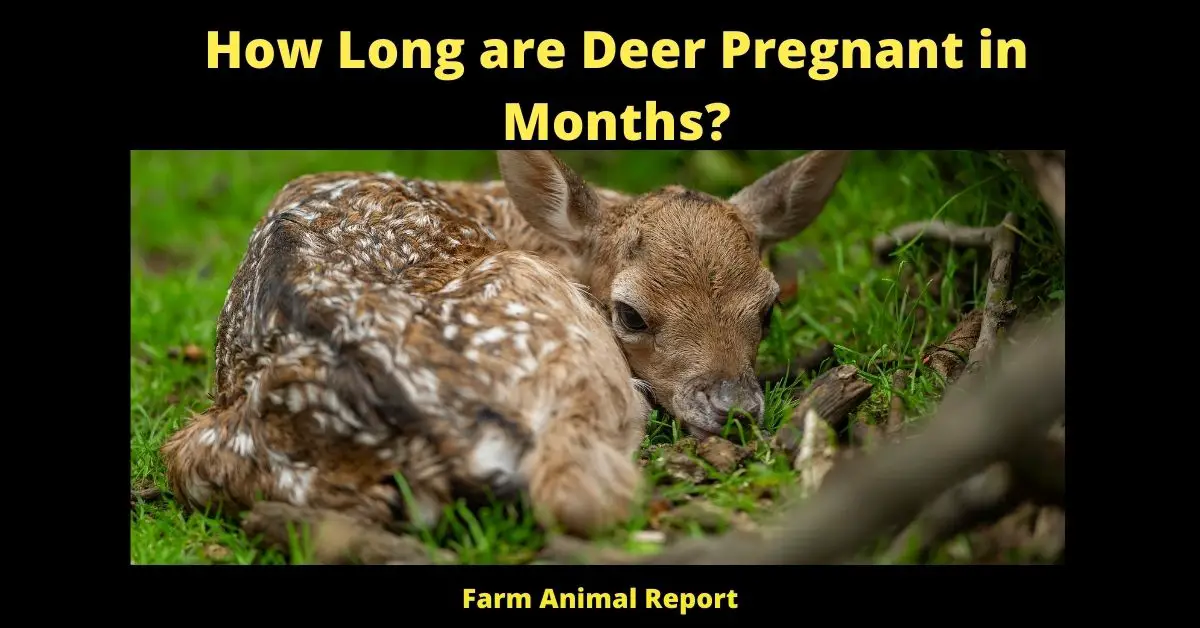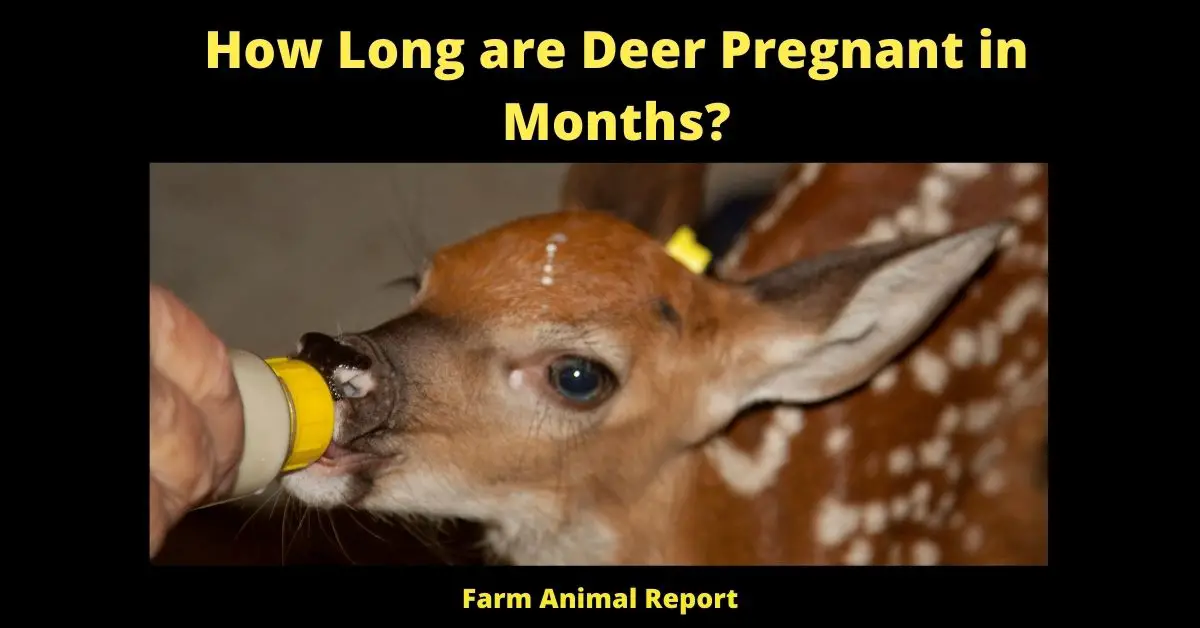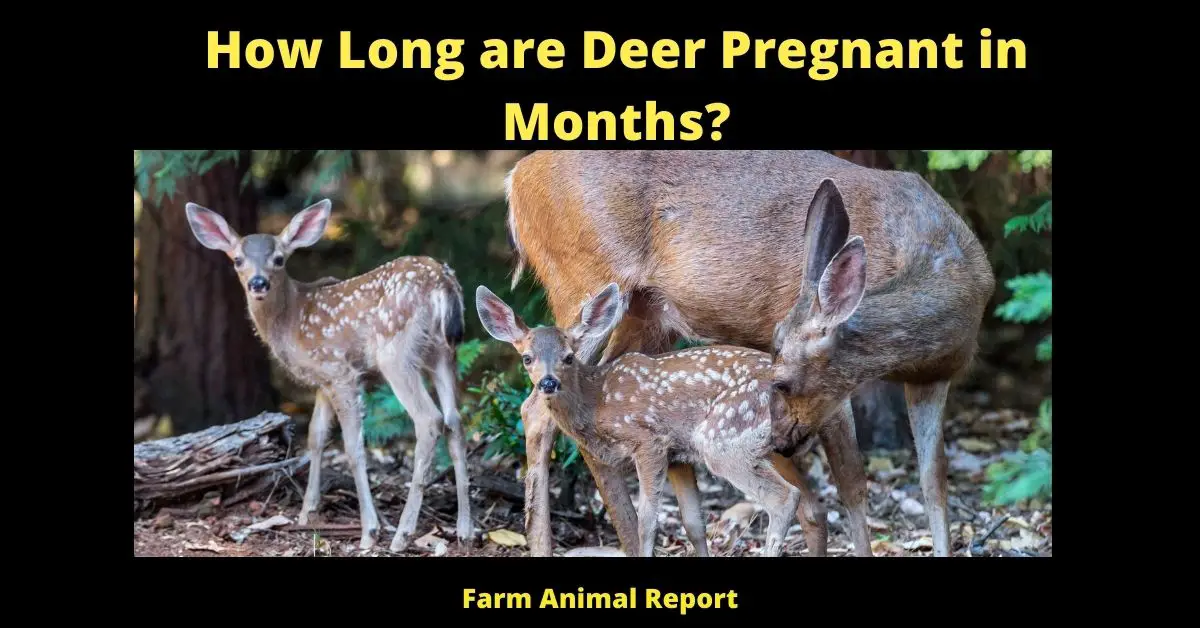How Long are Deer Pregnant – Deer are pregnant for 6 1/2 Months, or 200 days. Female deer, or does, typically have one fawn per litter. However, they can sometimes have twins or even triplets. Fawns are typically born in the spring, between late April and early June.
How Long are Deer Pregnant in Months?
Do you have questions about deer pregnancies? Wondering how long they gestate for? Wonder no more! In this blog post, we will answer all of your questions about deer pregnancies. We will discuss how long deer are pregnant in months, what signs to look out for during a doe’s pregnancy, and when the best time is to harvest a pregnant buck. How Long are Deer Pregnant | How long are Whitetail Deer Pregnant? Stay tuned!

What is the Average Gestation period for a Deer in Months, Days | Deer Pregnant
The average pregnancy time of a female Whitetail Doe in the United States is approximately six and a half months or around 200 days. There are variations in gestation periods from doe to doe, as well as region to region; so it is important to consult with your local wildlife biologist for the most accurate information about deer gestation periods in your area. Jump to How Long Are Deer Pregnant – ( FACTS & PHOTOS)
Generally, the peak of breeding activity occurs during late October and early November, and most does will give birth sometime between late May and early July. However, there is significant variation in the timing of births from year to year, so it is important to keep an eye on your local deer population throughout the spring and summer.
Check Out Amazons Educational Books on Whitetail Deer
How long are Whitetail Deer Pregnant? In some cases, bucks will mate with more than one doe during the breeding season, and in these cases, the gestation period will be slightly longer. For example, if a buck mates with two does, their offspring will average around 210 days old at birth. ( Whitetail Deer can vary a few days)
When are fawns usually Born in the Mid West of the United States | White Tailed Deer | Deer Breeding Season
The answer to this question depends on the location within the Mid West. In general, fawns are born in late May or early June. However, this can vary depending on the latitude and elevation of a particular area.
How Long are Deer Pregnant
- Colorado – For example, fawns in Colorado may be born as early as late April or as late as July. Fawns are generally born two at a time, but sometimes they are born one at a time or in litters of up to four. The doe will usually leave her fawns alone for the first few hours after birth so that they can activate their scent glands and avoid being detected by predators. Fawns are weaned around six weeks
- Pennsylvania – In Pennsylvania, fawns are usually born in late May.
- Wisconsin – In Wisconsin, they are generally born in early June.
- Michigan – And in Michigan, fawns are typically born around the middle of June.
- Texas – In texas, Fawns are usually born in late may.
- Ohio – In Ohio, fawns are usually born in early June.
- Indiana – In Indiana, they are generally born in late May or early June.
- Illinois – Fawns in Illinois are typically born in late May or early June.
- Iowa – Iowa deer hunters can expect to see fawns around the first of July
- Maine – In Maine, fawns are usually born in late May or early June.
- Minnesota – Minnesota deer hunters can expect to see fawns around the first of July.
- New Hampshire – New Hampshire deer hunters can expect to see fawns around the middle of June.
- New York – In New York, Fawns are usually born in late May or early June.
- North Carolina – Fawns in North Carolina are typically born in late May or early June.
- Pennsylvania – In Pennsylvania, fawns are usually born in late may.
- Rhode Island – Rhode island deer hunters can expect to see fawns around the first of July.
- South Carolina – In South Carolina, fawns are typically born in late May or early June.
- Tennessee – Tennessee deer hunters can expect to see fawns around the end of may.
- Virginia – Virginia deer hunters can expect to see fawns around the first of june.
- West Virginia – In West Virginia, fawns are usually born in late may.
- Wisconsin – Wisconsin deer hunters can expect to see fawns around the first of june.
- Wyoming – Fawns in Wyoming are typically born in early June.
- The best time to see a fawn is during the daylight hours when they are most active. However, if you do see a fawn during the evening or night hours, please leave it alone. It is best to observe from a distance and not disturb the animal in any way.
How long are Whitetail Deer Pregnant? Fawning periods can vary somewhat from year to year, so it’s a good idea to check with your local wildlife agency or conservation group for the most up-to-date information.
When is Rut for White tail Deer Normally come in these States | Deer Stay Pregnant | Deer Gestation Period
- Alabama – Late October/Early November.
- Alaska – Early September
- Arizona – Mid-October
- California – Early October
- Colorado – September
- Georgia – Early November
- Idaho – Late September/Early October.
- Illinois – Late October/Early November.
- Indiana – October
- Iowa – September
- Kansas – October
- Kentucky – Early November
- Maine – Early October
- Maryland – Mid-October
- Michigan – October
- Minnesota – October
- Mississippi – Mid-November
- Montana – Early October
- Nebraska – September/October
- New Hampshire – Early October
- New York – Late October/Early November
- North Carolina – Early November
- North Dakota– Late September to Early November
- Ohio – Mid-October
- Oklahoma – Early November
- Oregon – Early October
- Pennsylvania – Early October to Early November
- Rhode Island – Late October/Early November
- South Carolina – Early November
- South Dakota – Late September/Early October
- Tennessee – Early October
- Texas – Mid-October.
- Vermont – Early October
- Virginia – Early November
- Washington – Late September/Early October.
- West Virginia – Late September/Early October.
- Wisconsin– Early October to Mid-November.
- Wyoming – Early October

Do Male deer (bucks) help with the Birthing Process?Whitetail Deer
Male deer have been known to help in the birthing process of fawns. They have been seen licking and nuzzling the newborn deer, as well as guarding them against potential danger.
While the role of the male deer in birthing has not been fully studied, it is clear that they do provide some level of assistance. This could be due to the fact that male deer have a strong maternal instinct, or simply because they want to ensure the safety of the newborn.
How Many Fawns do Doe’s Female deer have per Litter | Mule Deer Gestation
Female deer, or does, typically have one fawn per litter. However, they can sometimes have twins or even triplets. Fawns are typically born in the spring, between late April and early June.
Misc Tags
- short-day breeder
- deer gestation periods
- breeding season males
- whitetail deer
- deer breeding season
- deer stay pregnant
- giving birth deer
- mule deer gestation
- female deer begin
- fawns
- deer gestation
- deer gestation period
- seven and a half months long
- mainly vary with species and seasons
- long hunting period
- hunting whitetail deer
- deer’s pregnancy
- fishing
- males
- young
- mainly vary with species and seasons
- red deer
- Big
They weigh about five pounds at birth and are able to walk within a few hours. Fawns are also able to run within a few minutes of being born and are very agile. They stay close to their mothers for the first few weeks of their lives, but eventually, start to roam around on their own. By the time they are six months old, they are usually independent.
How long are Fallow Deer Pregnant?
Fallow deer are a type of ruminant, which means that they have four stomach chambers that help them digest their food.
Fallow deer are known for their unique coloration, which can range from light brown to black. They are also distinguished by the white spots on their backs and sides. The pregnancy period for fallow deer is about 280 days, and they typically give birth to two or three fawns at a time. The fawns are born with their spots, but they gradually lose them as they get older.
Fallow deer generally live in herds of ten to 30 animals, but herds of up to 100 have been observed. The bucks usually stay with the herd while the does go off on their own to raise their fawns. When the fawns are old enough, they will join the herd as well. bucks will also often form small bachelor groups during the breeding season.
Fallow deer are native to Europe, Asia Minor, and the Middle East, but they have been introduced to many other parts of the world as well. In some areas, they are considered to be an invasive species due to their ability to outcompete other herbivores for food.
Mule deer Gestation Period
The gestation period of a mule deer is approximately 198 days. During this time, the pregnant doe will gain weight and her belly will swell as the fawn grows inside of her.
Around the time of birth, the doe will begin to build a nest in which to give birth. The fawn will be born blind and helpless and will rely on its mother for warmth, milk, and protection.
For the first few weeks of life, the fawn will spend most of its time hiding in the nest, only emerging to nurse or drink water. As it grows older and stronger, the fawn will begin to explore its surroundings and learn to fend for itself. However, it will remain with its mother for up to 18 months before striking out on its own.
How Many Times Can a Deer Get Pregnant in a year?
Several Matings – One Labor and Birth – A buck can breed doe as early as six months old, but six to eight months is more common. Most bucks bred younger than 6 months old are yearlings that have not reached full antler or body development potential.
Bucks older than 2-1/2 years old rarely breed young does. The ideal breeding age for a buck is 2-1/2 to 4-1/2 years old. A doe can get pregnant at around six months old. A fawn’s first set of spots usually appears within two weeks after birth and they are fully grown by the time they are 3 to 5 months old.
Does usually have one to three fawns at a time, but it’s not uncommon for them to have twins or even triplets. Regardless of the number of fawns, nutrition and habitat play key roles in a fawn’s survival during its first year. In general, whitetails breed from mid-October until early December, with peak rutting activity ($) typically occurring in November.
However, deer in some areas may breed any time from late September through January depending on latitude, temperature, and day length (photoperiod). Does usually enter estrus (Heat) every 28 days and conceive soon thereafter if they fail to mate during estrus. However, poor nutrition can delay estrus or result in embryonic death prior that would result in the doe re-entering estrus soon thereafter (cyclic breeding).
Research has shown that as many as 30% of does can enter estrus and conceive a second time if their fawn is lost early in the season or if they receive good nutrition late in the season. Also, if doe mates very early or very late in the breeding season she may remain pregnant throughout the winter (delayed implantation) and give birth the following spring when conditions are more favorable for her fawn’s survival.
In addition to cyclic breeding and delayed implantation, a third mechanism that allows deer to have multiple fawns per year is superfetation (i.e., conceiving a second litter while still pregnant with the first). This phenomenon has been observed most commonly in white-tailed deer living in quality Habitats where nutrition is not limiting.
Superfetation occurs when a doe conceives a second litter before her current pregnancy is far enough along that she cannot re-mate and conceive again. Consequently, she gives birth to two litters conceived weeks apart.
Although this allows a doe to produce two sets of twins in a single year, superfetation generally reduces productivity because it results in a smaller body size at birth for both litters relative to what would occur if she only had one litter per year. Consequently, both groups of twins are less likely to survive their first winter than if they had only one litter per year.
Under optimal conditions and without predation, whitetail deer populations can increase by 20% per year. However, population growth rates that high are rare because few deer live in unbroken, high-quality habitats, most females produce only twins, many fawns die before their first birthday, and most adults live less than 5 years.
Nevertheless,if you find yourself hunting an area with lots of small bucks and twinning does it is likely because there was quality habitat available allowing those animals to reach their maximum potential. So there you have it hunters,a breakdown of how many offspring a deer can realistically have per year given different environmental factors. Stay safe out there this season.
How Long Is Deer Labor?
Knowing how long deer labor is can be helpful information for hunters. After all, if you know when the doe is going to drop her fawn, you can be in the right place at the right time. The length of deer labor can vary depending on a number of factors, including the size of the fawn and the doe’s state of health.
However, most does will give birth within a 24-hour period. So, if you see a doe that appears to be in labor, it’s best to give her some space and wait for her to deliver her fawn.
Once the fawn is born, the doe will clean it up and then begin nursing. The whole process usually takes less than an hour. So, if you’re patient, you may just be able to witness one of nature’s miracle births.
Do Deer Give Birth Standing Up?
While deer are generally born while the mother is standing, they usually lie down to do so. There are a few reasons for this.
First of all, it’s easier for the fawn to emerge from the birth canal when the mother is lying down. This position also allows gravity to help with the delivery. Additionally, it gives the fawn a better chance of surviving if predators are nearby.
The fawn will be hidden by its mother’s body and will be less likely to be seen or smelled. However, there are times when a doe will give birth while standing, particularly if she is startled or feels threatened. In such cases, she may not have time to lie down before her baby is born. Ultimately, whether a deer gives birth standing up or lying down depends on the circumstances at the time.
What do Deer Do after Giving Birth?
After a doe has given birth, she will clean off the fawn as best she can. Next, she will consume the placenta and umbilical cord. It is very important that she does this as it contains nutrients and minerals that her body needs in order to heal and recover from the stress of childbirth.
The doe will also begin to produce colostrum, a thick yellowish fluid that is high in antibodies and essential for the fawn’s immune system. For the first few weeks of life, the fawn will spend most of its time hiding in tall grass or under bushes.
The doe will visit her fawn several times a day to nurse, but otherwise will keep her distance in order to avoid attracting predators. As the fawn grows older and stronger, it will begin to spend more time with its mother and other members of the herd.
Unique Facts about Pregnant Deer
- Pregnant deer are called “doe” and can carry a single fetus for over 6 months. Doe give birth to their fawns in the early summer months, usually in late May or early June.
- Fawns are born with a protective coating of white spots that provide camouflage in their natural environment.
- Doe can be pregnant again within days of giving birth and typically give birth to one to three fawns at a time.
- Doe are highly protective of their fawns and will often leave them alone when they go off to feed.
- Doe have a gestation period of around 200 days.
- During the last few weeks of their pregnancy, doe will often seek out a secluded area to give birth.
- Doe are able to recognize their own fawns by scent and will vigorously defend them against predators.
- Doe feed their fawns milk for the first four to eight weeks of their lives.
- Fawns are able to stand and walk shortly after birth, but often remain hidden in the grass for protection until they are strong enough to keep up with their mother.
- Doe and fawns often form strong social bonds and will remain together for up to two years.
Deer are one of the most majestic creatures in nature. They are beautiful, graceful, and powerful, and they have captivated us for centuries. We know that deer are mammals, and that like all mammals, they give birth to their young. But how long are deer pregnant for? In this blog, we will explore the gestation period of deer, including how long they are pregnant for and what happens during the pregnancy.
How Long Do Deer Stay Pregnant?
Deer pregnancies can last anywhere from 180 to 240 days, depending on the type of deer. Whitetail deer, for example, are usually pregnant for about 195 days, while mule deer are typically pregnant for about 200 days.
Deer Gestation Period
The gestation period for deer is divided into three parts. The first part is the pre-pregnancy period, which is when the doe prepares her body for conception. During this period, she will eat more food and exercise more often. The second part is the actual pregnancy, which lasts for about 7 months, and the third part is the post-pregnancy period, during which the doe will nurse her young and help them become independent.
How Long Are Deer Pregnant For?
The length of a deer’s pregnancy depends on the type of deer. For whitetail deer, the gestation period is usually around 195 days, while mule deer pregnancies usually last for about 200 days. The gestation period for other types of deer may vary, so it’s important to research the specific species of deer you’re interested in.
How Long is a Whitetail Deer Pregnant?
Whitetail deer are usually pregnant for about 195 days. During this period, the doe will prepare her body for pregnancy and then give birth to her young. The doe will then nurse her young and help them become independent.
How Long Are Whitetail Deer Pregnant?
Whitetail deer are usually pregnant for about 195 days. During this period, the doe will prepare her body for pregnancy and then give birth to her young. The doe will then nurse her young and help them become independent.
How Long Does a Deer Stay Pregnant? How Long is a Deer Pregnant?
Most types of deer are pregnant for between 180 and 240 days, depending on the species of deer. For example, whitetail deer are usually pregnant for about 195 days, while mule deer pregnancies typically last for about 200 days.
How Long is a Doe Pregnant For?
Most types of deer are pregnant for between 180 and 240 days, depending on the species of deer. For example, whitetail deer are usually pregnant for about 195 days, while mule deer pregnancies typically last for about 200 days.
Final Thoughts – How Long are Deer Pregnant in Months?
How long are Whitetail Deer Pregnant? White-tailed deer are the most common species of deer in North America
A female deer called a Doe will carry her babies for 6 1/2 months or approximately 200 Days.





